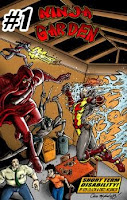How forming new memories help retain older ones

Now recall visual paired associate AB:

Next, try to remember this new visual paired associate (AC):

Now recall visual paired associate AC:

Can you still remember the first visual paired associate AB? (probably, it wasn't that hard)
What if I were to pay you ten cents to remember? How about if I increased it to a hundred bucks? Would your memory performance increase? Stay the same? Most of you would probably infer the former. More money = more motivation to memorize.
That's what Kuhl and colleagues found in their study published in the latest issue of Nature Neuroscience. However, the study didn't just stop there. That's just the tip of the iceberg!
They had all participants complete a task similar to the one just demonstrated, but used more novel pairings such as a watch and a pipe (yawn). Trials began either with a high or a low reward tagged to an AB pair and a high, low, or no reward tagged to an AC pair (interference). There were 8 encoding and immediate test rounds and 1 critical post-test round conducted outside of the scanner. Here participants were asked to recall AB pairs only. As expected, retroactive interference negatively affected memory retrieval of AB pairs.
Using fMRI, the authors found that left hippocampal activation during the learning of a latter visual paired associate predicted how well the first paired associate would be remembered. Basically, if your left memory cortex didn't light up while encoding new information then the relatively older information was most likely forgotten. More specifically, for those of you who couldn't remember the first pair (horse and no-name comic book) it's highly probable that your left posterior hippocampus and parahippocampal cortex weren't activated during the learning of the latter pair (horse and Sarah Jessica Parker).
Reprinted by permission from Macmillan Publishers Ltd: Nature Neuroscience, advance online publication, 28 February 2010 (doi: 10.1038/sj.nn.2498)
Furthermore, the researchers found that when successful recall for AB pairs were achieved, reward centers in the brain (fronstriatal regions) also lit up on fMRI scan.
So how can all of this be explained? According to the authors, hippocampal reactivation is protecting the stored episodic memories from being forgotten in the face of interfering information. The authors chalk it up to pattern completion which "allows previously encoded memories to be reinstated from a partial input, thereby allowing past episodes to be reactivated, interleaved with current experience, and consolidated over time". The horse not only serves as a retrieval cue for the memory of Sarah Jessica Parker, but the no-name comic book as well.
Additionally, the findings underscore the importance of past reward-associated (motivated) learning and its incorporation into new learning experiences.
(Santiago Ramón y Cajal's drawing of the hippocampus)
This study leads me to wonder what key factors contribute to individual differences in memory encoding after performing an interference task. Is it just hippocampal functioning and level of motivation that sets each and every one of us apart? What about working memory capacity (prefrontal and parietal areas)? Intelligence? Age? Level of alertness? Amount of sleep prior to and/or after learning? All the above? Anyway, it's time to end this pointless musing. Back to more important matters like tending to Ninja Garden Issue 1.
References:
Kuhl, B., Shah, A., DuBrow, S., & Wagner, A. (2010). Resistance to forgetting associated with hippocampus-mediated reactivation during new learning Nature Neuroscience, 13 (4), 501-506 DOI: 10.1038/nn.2498


